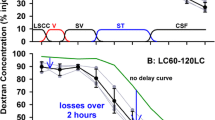Abstract
In cases of slow or limited penetration of an antibiotic to the site of infection such as in acute otitis media (the middle ear), plasma levels of the agent may not reflect the concentrations that are relevant in determining clinical outcome. There is a need for a model that allows prediction of the time-course of unbound, pharmacologically active drug levels in middle ear fluid (MEF). This article introduces microdialysis as a sampling tool to measure unbound antibiotic concentrations in the MEF of the chinchilla, and briefly summarizes the results of studies of MEF penetration of a cephalosporin, a macrolide, and a ketolide antibiotic using this technique. The general concurrence of preliminary results of the chinchilla studies with clinical findings suggests that the chinchilla microdialysis model may be useful in predicting efficacy in patients.
Similar content being viewed by others
References
Blumer JL. Fundamental basis for rational therapeutics in acute otitis media.Pediatr Infect Dis J. 1999;18:1130–1140.
Faden H, Duffy L, Boeve M. Otitis media: back to basics.Pediatr Infect Dis J. 1998;17:1105–1113.
Klein JO. Clinical implications of antibiotic resistance for management of acute otitis media.Pediatr Infect Dis J. 1998;17:1084–1089.
Blumer JL. Pharmacokinetics and pharmacodynamics of new and old antimicrobial agents for acute otitis media.Pediatr Infect Dis J. 1998;17:1070–1075.
Block SL. Causative pathogens, antibiotic resistance and therapeutic considerations in acute otitis media.Pediatr Infect Dis J. 1997;16:449–456.
Giebink GS, Canafax DM, Kempthorne J. Antimicrobial treatment of acute otitis media.J Pediatr. 1991;119:495–500.
Craig WA, Andes DR. Pharmacokinetics and pharmacodynamics of antibiotics in otitis media.Pediatr Infect Dis J. 1996;15:255–259.
Elm quist WF, Sawchuk RJ. Application of microdialysis in pharmacokinetic studies.Pharm Res. 1997;14:267–288.
Huang Y, Ji P, Inano A, Yang Z, Giebink GS, Sawchuk RJ. Microdialysis studies of the middle ear distribution kinetics of amoxicillin in the awake chinchilla.J Pharm Sci. 2001;90:2088–2098.
Zhu T, Cheung BW, Cartier LL, Giebink GS, Sawchuk RJ. Simultaneous intravenous and intramiddle-ear dosing to determine cefditoren influx and efflux clearances in middle ear fluid in freely moving chinchillas.J Pharm Sci. 2003;92:1947–1956.
Hanamure Y, Lim DJ. Anatomy of the chinchilla bulla and eustachian tube. I. Gross and microscopic study.Am J Otolaryngol. 1987;8:127–143.
Vrettakos PA, Dear SP, Saunders JC. Middle ear structure in the chinchilla: a quantitative study.Am J Otolaryngol. 1988;9:58–67.
Giebink GS. Otitis media: the chinchilla model.Microb Drug Resist. 1999;5:57–72.
Canafax DM, Nonomura N, Erdmann GR, Le CT, Juhn SK, Giebink GS. Experimental animal models for studying antimicrobial pharmacokinetics in otitis media.Pharm Res. 1989;6:279–285.
Jossart GH, Erdmann GR, Livett DG, et al. An experimental animal model for measuring middle ear antimicrobial drug penetration in otitis media.Pharm Res. 1990;7:1242–1247.
Wang Y, Wong SL, Sawchuk RJ. Microdialysis calibration using retrodialysis and zero-net flux: application to a study of the distribution of zidovudine to rabbit cerebrospinal fluid and thalamus.Pharm Res. 1993;10:1411–1419.
Ji P.Distribution Kinetics of Cefdinir Between Plasma and Middle Ear Fluid in Chinchilla [dissertation]. Minneapolis, MN: University of Minnesota; 2004.
Bryskier A. Novelties in the field of anti-infectives in 1997.Clin Infect Dis. 1998;27:865–883.
Ma Z, Clark RF, Or Y. Design synthesis and characterization of ABT-773: a novel ketolide highly active against multidrug resistant pathogens. Proceedings of the 39th Interscience Conference on Antimicrobial Agents and Chemotherapy; September 26–29, 1999; San Francisco, CA. Washington, DC: American Society for Microbiology; 1999: 345.
Edelstein PH, Edelstein MA. In vitro activity of the ketolide HMR 3647 (RU 6647) forLegionella spp, its pharmacokinetics in guinea pigs, and use of the drug to treat guinea pigs withLegionella pneumophila pneumonia.Antimicrob Agents Chemother. 1999;43:90–95.
Agouridas C, Bonnefoy A, Chantot JF. Antibacterial activity of RU 64004 (HMR 3004), a novel ketolide derivative active against respiratory pathogens.Antimicrob Agents Chemother. 1997;41:2149–2158.
Shortridge D, Ramer NC, Beyer J, et al. The in vitro activity of ABT-773 against gram-positive and gram-negative pathogens. Proceedings of the 39th Interscience Conference on Antimicrobial Agents and Chemotherapy; September 26–29, 1999; San Francisco, CA. Washington, DC: American Society for Microbiology; 1999: 346.
Liu W.Distribution Kinetics of the Ketolide Antibiotic, Cethromycin, to Chinchilla Middle Ear [dissertation]. Minneapolis, MN: University of Minnesota; 2004.
Babl FE, Pelton SI, Li Z. Experimental acute otitis media due to nontypeableHaemophilus influenzae: comparison of high and low azithromycin doses with placebo.Antimicrob Agents Chemother. 2002;46:2194–2199.
Author information
Authors and Affiliations
Corresponding author
Rights and permissions
About this article
Cite this article
Cheung, B.W.Y., Liu, W., Ji, P. et al. The chinchilla microdialysis model for the study of antibiotic distribution to middle ear fluid. AAPS J 8, 5 (2006). https://doi.org/10.1208/aapsj080105
Received:
Accepted:
Published:
DOI: https://doi.org/10.1208/aapsj080105




